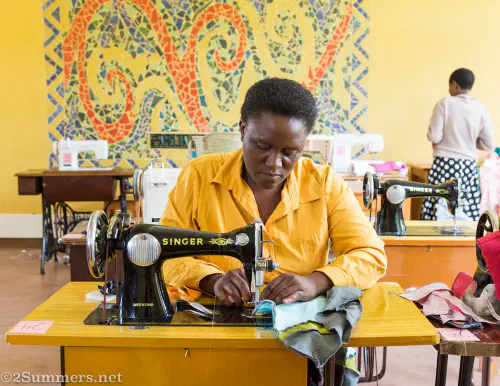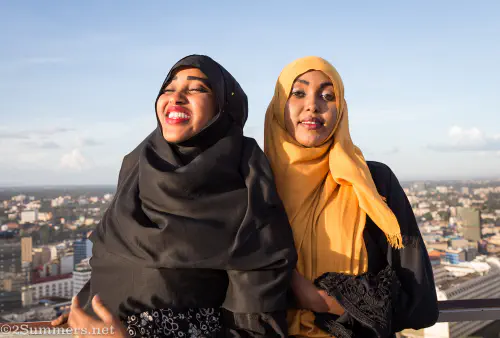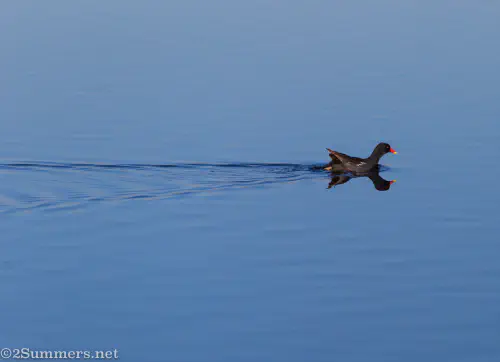Baby Elephants, Hungry Giraffes, and Other Cool Stuff in Karen
Karen is a suburb of Nairobi named for Danish farmer Karen Blixen (a.k.a. Meryl Streep), author of Out of Africa. The area was developed on the site of Blixen’s early 20th-century farm, where Out of Africa was filmed.
I spent two days of my weeklong trip to Nairobi exploring Karen, which is anywhere from 20 minutes to an hour (or more) from downtown Nairobi, depending on traffic. It’s an alluring place – quiet, heavily forested, scattered with colonial estates and shady tea gardens. I decided to write a separate post about Karen because it’s so different and far-removed from central Nairobi. Karen is also filled with great tourist attractions.
Karen’s 6 Best Tourist Attractions
Here are the six coolest things I did in Karen.
1) The David Sheldrick Wildlife Trust
If you like animals and have time to do one thing in Karen, visit the David Sheldrick Wildlife Trust (DSWT).

DSWT is legendary in the animal conservation community – the first organization to raise orphaned elephant calves and integrate them back into the wild. Daphne Sheldrick, founder of the trust, developed a special a formula that substitutes for elephant breast milk and pioneered a process in which elephant calves are raised by human keepers. DSWT also raises orphaned baby rhinos.
Each day at 11:00 a.m., DSWT opens to the public during the elephants’ midday feeding and mud bath. The elephants come running out, excited for their meal, and the keepers feed them from giant bottles of milk and small tree branches.


Visitors gather behind ropes around the feeding area and some are lucky enough to touch the elephants if they come close.
One of the keepers addresses the crowd, explaining the mission of DSWT and introducing each elephant. He explains how each one was orphaned and came to live at DSWT. Most of the elephants are orphaned due to poaching, falling into wells, or other human-wildlife conflict.


Once the elephants are big enough they are moved to another DSWT facility in Tsavo National Park, where their care continues and they are gradually re-introduced into the wild elephant population.

It’s best to arrive between 10:30 and 10:45 to get in line and pay your money so you can find a good spot to watch the elephants. Admission to DSWT is KES5000 (about $5) – bring cash. The feeding and presentation lasts for an hour.
2) Karen Blixen Museum
I visited the Karen Blixen Museum, which is in the farmhouse where Karen used to live, feeling unsure of whether or not I would enjoy it. I’ve read Out of Africa and saw the movie but couldn’t remember much about either one.
I was pleasantly surprised and really loved this tour.

Each visitor or group of visitors to the Karen Blixen Museum is paired with a guide; I was alone so I had Margaret to myself. The tour of the house and grounds takes about 45 minutes and is informative and succinct. Most of the furnishings in the house were Karen’s actual things.


More than the tour itself, I was impressed by Margaret. She is an intern at the museum and had only been there for a few weeks, but she did a fantastic job describing Karen’s life and everything about the house. I asked Margaret if she finds it strange that the Kenyan government maintains this museum, which seems like a legacy to white colonialism. Margaret answered that she considers Karen Blixen a role model – a woman who was brave in the face of adversity and stood up for the rights of other women. I couldn’t argue with that.
The Karen Bixen Museum costs KES1200 ($12) for adults and KES600 for children.
3) Kazuri Beads
Kazuri Beads is a factory and shop in Karen, producing high-quality ceramic beads and pottery. Kazuri has about 340 employees, mostly women, and visitors are welcome to tour the factory.





Kazuri Beads is touristy. I was a little put off by the gang of American visitors doling out candy to the employees as if they were children, and I suspect that my taxi driver received a kick-back for bringing me there. Nonetheless, I love visiting factories like this, it seems like a nice place to work, and the beads are beautiful. I recommend visiting if you enjoy African crafts. Be prepared for quasi-Western prices.
4) Nairobi National Park
I’m cheating a little by including Nairobi National Park in my post about Karen. The park is not actually in Karen – in fact it’s a huge piece of land (120 square kilometers, or 45 square miles) right in the middle of Nairobi – but it partially borders Karen and I didn’t have space to include it in my other post.
Nairobi National Park is remarkable in that it’s a wild game reserve – with rhinos, lions, giraffes, hyenas, ostriches, etc. – in the middle of one of Africa’s largest cities. I spent a day there with my friends Michelle and Conrad and their friends Rachel and Robin (who drive a Landcruiser perfect for safaris), and we had plenty of great sightings.

A knock-kneed hartebeest in Nairobi National Park, with the city in the distance.

Mama and baby vervet monkey.


We didn’t see any lions but we did see a distant black rhino.
Admission for Nairobi National Park is $43 for non-resident adults and $22 for non-resident children.The main entrance is on Langata Road, close to Karen.
5) The Giraffe Centre
I was wary of the Giraffe Centre, as I generally don’t support attractions that allow interaction between wildlife and the general public. The Giraffe Centre is a breeding facility for endangered Rothschild giraffes, and visitors are encouraged to feed the giraffes from a raised viewing platform.


Wow, giraffes’ tongues are really long.
I listened to an educational talk at the centre and chatted for a while with one of the staff – another knowledgeable young intern. I left feeling like the Giraffe Centre is legit. It’s been around for nearly 40 years an seems to be doing a worthy service by breeding endangered giraffes and releasing them into Kenyan national parks. (I’m not sure how many giraffes are released into the wild and how many spend their lives in captivity.)
Supposedly the human feeding isn’t bad for the giraffes, as they only approach the viewing platform if they wish to and they have plenty of other food sources. But I’m open to feedback from the wildlife experts out there as to whether or not this is a good thing.

The Giraffe Centre costs KES1000 ($10) for non-resident adults and KES500 for children. Admission includes access to the nature sanctuary across the road. You can also book accommodation and afternoon tea at Giraffe Manor, the high-end boutique hotel on the property where giraffes occasionally stick their heads through the windows.
6) Ngong Hills
Again, this is a bit of a cheat because the Ngong Hills are quite a few kilometres away from Karen in Ngong Town. But the Ngong Hills are clearly visible from Karen – they feature prominently in Out of Africa – and Karen is a good base from which to get to the Ngong Hills.

These hills are famous because they look like four knuckles (that’s what Ngong means), and because they overlook the Great Rift Valley. The hills are part of the Ngong Hills Forest reserve, which has hiking trails and a huge windmill farm at the top.

We went up just before sunset in Robin and Rachel’s Landcruiser, and set up a sundowner spread. The views were incredible but it was cold beyond belief – there’s a reason why windmills do well up there. Warm clothes are a must for the Ngong Hills.


It’s best to have your own transport to go to the Ngong Hills. I wouldn’t mind doing the hike someday. Visitors must pay admission to enter the reserve – I think I paid about $5 as a foreigner.
If you’re passing through Nairobi, definitely budget a day or two for Karen. But don’t forget the rest of Nairobi as it’s quite a different scene.
That’s all on Nairobi for now – back to our regular 2Summers programming.




Comments
I remember reading Maribou Stork Nightmares years ago and then seeing them for the first time in SA and the whole book making a lot more sense.
Hahaha. They are very nightmarish.
I’ve also thought the Maribou stork is like the ugliest bird in the world but have softened in my old age. They’re quite lovely. As is everything else.
I agree. They are nightmarish in the prettiest possible way.
Lovely post. So I wasn’t going to be nitpicky but since they are mentioned in the comments too: I’m pretty sure it’s Marabu stork, not Maribou. You might be thinking Caribou which is a type of reindeer:-) But I didn’t google it so I might be mistaken…
Oh my goodness, you’re right! Don’t ever hesitate to correct me on mistakes - I want to be corrected :)
LOL. That’s how I feel - I hate to make mistakes. But I also hate to be the spoilsport lecturing people, so thanks for giving me permission beforehand for future corrections, you can always return the favor:)
And PS: It’s actually Marabou – a combination of my original spelling and yours. Ha!
This is just the sort of thing I love about your blog….cheerful and positive!
Haha, I knew I should have Googled it first. Now I learned something too!
I’m very curious as to how the DSWT is able to release human-raised elephants back into the wild. I’ll have to check out their website and see.
Love the pictures and my God, you just do not realize how big a giraffe’s head is until you see it up close and personal. WOW.
I think elephants can adjust better to the wild than most other animals can, due to their size and intelligence. I’m sure it’s still problematic in many cases though.
Wonderful and thought-provoking as usual. I had one pause at the picture of the dog. Why does it have a chain around its neck [that looks easy to remove] and is that a piece of wire hanging from it? It looks like it escaped from somewhere or someone, and that bothered me.
Yes, it was very upsetting. I think it was a dog that lives in the area that is usually chained but at some point slipped free. She was very clearly domesticated and very sweet, but also very hungry. We fed her as much as we could. When we packed up to leave she ran off, seemingly knowing exactly where she was going. We all bemoaned the situation and wished we could take her home but…Just one of those realities of life in the developing world ????